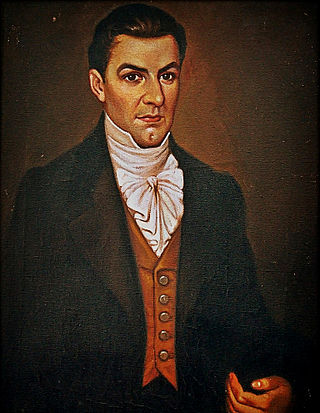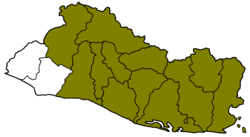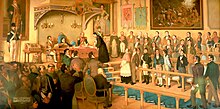
Manuel José Arce y Fagoaga was a decorated Salvadoran General and president of the Federal Republic of Central America from 1825 to 1829, followed by Francisco Morazán.

José Rafael Carrera y Turcios was the president of Guatemala from 1844 to 1848 and from 1851 until his death in 1865, after being appointed President for life in 1854. During his military career and presidency, new nations in Central America were facing numerous problems: William Walker's invasions, liberal attempts to overthrow the Catholic Church and aristocrats' power, the Civil War in the United States, Mayan uprising in the east, Belize boundary dispute with the United Kingdom, and the wars in Mexico under Benito Juárez. This led to a rise of caudillos, a term that refers to charismatic populist leaders among the indigenous people.

Ahuachapán is a city, and municipality, and the capital of the Ahuachapán Department in western El Salvador. The municipality, including the city, covers an area of 244.84 km² and as of 2007 has a population of 110,511 people. Situated near the Guatemalan border, it is the westernmost city in the country and is the center of an agricultural region producing primarily coffee.

Francisco Luis Héctor de Carondelet y Bosoist, 5th Baron of Carondelet, was a Spanish administrator of partial Burgundian descent in the employ of the Spanish Empire. He was a Knight of Malta.
Listed below are the dates and results for the 1994 FIFA World Cup qualification rounds for the North, Central American and Caribbean zone (CONCACAF).

The Captaincy General of Guatemala, also known as the Kingdom of Guatemala, was an administrative division of the Spanish Empire, under the viceroyalty of New Spain in Central America, including the present-day nations of Costa Rica, Nicaragua, Honduras, El Salvador, and Guatemala, and the Mexican state of Chiapas. The governor-captain general was also president of the Royal Audiencia of Guatemala, the superior court.

José Matías Delgado y de León was a Salvadoran priest and doctor known as El Padre de la Patria Salvadoreña.

Pedro Ortiz de la Barriere Castro was a Spanish politician, military officer, and lawyer who served as the colonial intendant of the Intendancy of San Salvador from 1819 until 1821. He also served the first head of state of the Province of San Salvador after the signing of the Act of Independence of Central America from September to November 1821. He was killed in action at the Battle of Milingo during the First Central American Civil War.

The 1811 Independence Movement, known in El Salvador as the First Shout of Independence, was the first of a series of revolts in Central America in modern-day El Salvador against Spanish rule and dependency on the Captaincy General of Guatemala. The independence movement was led by prominent Salvadoran and Central American figures such as José Matías Delgado, Manuel José Arce, and Santiago José Celis.
The Real Audiencia of Santiago de Guatemala, simply known as the Audiencia of Guatemala or the Audiencia of Los Confines, was a Real Audiencia in the Imperial Spanish territory in Central America known as the Captaincy General of Guatemala (1609-1821). The Audiencia's presiding officer, the president, was the head of the government of the area. The Audiencia was initially created by decrees of November 20, 1542 and September 13, 1543, and had its seat in Antigua Guatemala.

The Act of Independence of Central America, also known as the Act of Independence of Guatemala, is the legal document by which the Provincial Council of the Province of Guatemala proclaimed the independence of Central America from the Spanish Empire and invited the other provinces of the Captaincy General of Guatemala to send envoys to a congress to decide the form of the region's independence. It was enacted on 15 September 1821.

Mariano de Aycinena y Piñol was wealthy and influential Guatemalan merchant family and an important conservative politician. A younger son of the first marquis of Aycinena, peninsular-born Juan Fermín de Aycinena (1729-1796), Mariano was a leader of Guatemalan independence from Spain. He served governor of the State of Guatemala in the Central American Federation from 1 March 1827 to 12 April 1829 and patriarch of the Aycinena family. The family had the commercial monopoly in Central American during the Spanish colonial era later year thanks to the Consulado de Comercio. He was one of the signatories of Central American independence and lobbied heavily for the annexation of Central America to the Mexican Empire of Agustín de Iturbide. This arrangement would keep the family's economic position and privileges following independence. After being expelled along with the Aycinena family in 1829 after being defeated by Francisco Morazán, went into exile in the United States and then to Mexico. He came back to Guatemala after the conservatives had allied with general Rafael Carrera; but then he retired from public life and hand the Aycinena family leadership to Juan José de Aycinena y Piñol.

El Salvador–Spain relations are the current and historical relations between El Salvador and Spain. Both nations are members of the Association of Academies of the Spanish Language, Organization of Ibero-American States and the United Nations.

The First Central American Civil War was a civil political and military conflict within the Federal Republic of Central America which lasted from 1826 until 1829. The civil war was fought between Liberal and Conservative lines with Francisco Morazán leading the Liberals and Manuel José Arce, a former Liberal, leading the Conservatives.

The Colonial Intendant of San Salvador was a political position created in 1786 to govern the Intendancy of San Salvador, modern-day El Salvador, that was a part of the Captaincy General of Guatemala, which itself was a part of the Viceroyalty of New Spain, a Spanish colony. The position was abolished on 21 September 1821 with the independence of Central America.
Antonio Basilio Gutiérrez y Ulloa was a Spanish politician and bureaucrat. He held various offices in Spain, San Salvador, New Spain, and Mexico. His most notable political office was being the Colonial Intendant of the Intendancy of San Salvador from 1805 until he was deposed in the 1811 Independence Movement. Unlike other Spanish colonial administrators, Gutiérrez y Ulloa held no military background.

The Mayor of San Salvador is the head of the municipal government of the city of San Salvador, the capital city of El Salvador.

José Alejandro de Aycinena y Carrillo was a Spanish military officer and politician who served as the Colonial Intendant of the Intendancy of San Salvador from 1811 to 1812.

From January 1822 to July 1823, the Captaincy General of Guatemala, a former Spanish colony, was controlled by the First Mexican Empire, and briefly, the Supreme Executive Power—the provisional government that succeeded Mexican imperial rule. The captaincy general consisted of the provinces of Chiapas, Costa Rica, El Salvador, Guatemala, Honduras, and Nicaragua—the six southernmost provinces of the Mexican Empire. The incorporation of Central America brought Mexico to the height of its territorial extent.



















